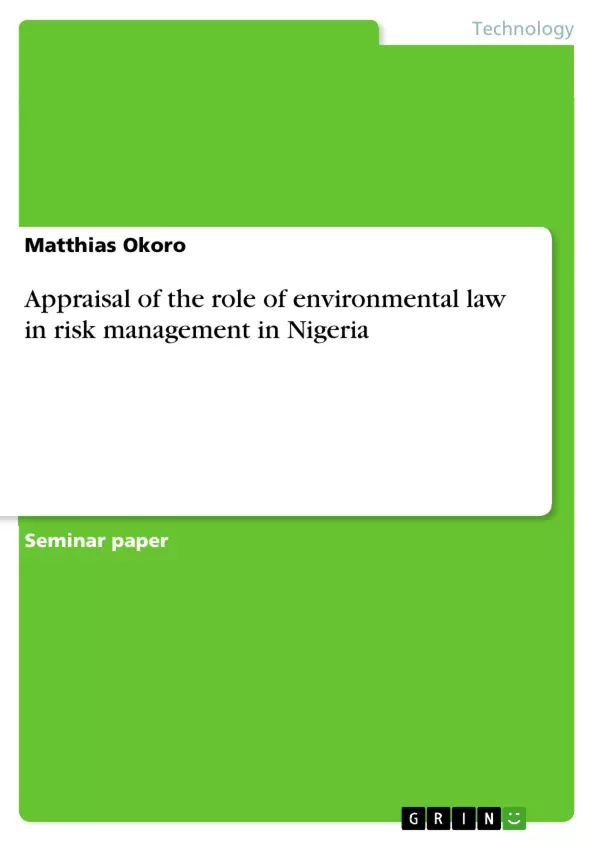In ideal risk management, a prioritization process is followed whereby the risks with the greatest loss (or impact) and the greatest probability of occurring are handled first, and risks with lower probability of occurrence and lower loss are handled in descending order. In practice the process of assessing overall risk can be difficult, and balancing resources used to mitigate between risks with a high probability of occurrence but lower loss versus a risk with high loss but lower probability of occurrence can often be mishandled. Intangible risk management identifies a new type of a risk that has a 100% probability of occurring but is ignored by Government or organization due to a lack of identification ability. In Nigeria, some time, this is what is obtainable in the social and physical environment. In view of the above fact, environmental laws have been put in place to regulate every activity on the environment to manage the risk involved in these process and stage of development in other to avoid an impending or a looming catastrophe. According to the International Network for Environmental Compliance and Enforcement (INECE), the major environmental issues in Nigeria are “drought and flooding, air pollution, deforestation, loss of biodiversity, freshwater availability, degradation of soil and vegetation, and widespread poverty.” Government and other organizations hope to provide protection and mitigation regarding pollution and other disasters before their impacts contaminate the African environment as well as the global environment. Therefore chronicled in this write up, is the appraisal of the role of Environmental Law in risk management.
Inhaltsverzeichnis (Table of Contents)
- Chapter One
- Introduction
- Risk
- Risk Management
- Method
- Principles Of Risk Management
- Process
- Establishing The Context
- Identification
- Assessment
- Composite Risk Index = Impact Of Risk Event X Probability Of Occurrence
- Risk Options
- Potential Risk Treatments
- Risk Avoidance
- Hazard Prevention
- Risk Reduction
- Risk Sharing
- Risk Retention
- Create A Risk Management Plan
- Implementation
- Review And Evaluation Of The Plan
- Limitations
- Areas Of Risk Management
- Enterprise Risk Management
- Risk Management Activities As Applied To Project Management
- Risk Management For Megaprojects
- Risk Management Regarding Natural Disasters
- Risk Management Of Information Technology
- Risk Management Techniques In Petroleum And Natural Gas
- Positive Risk Management
- Risk Management And Business Continuity
- Risk Communication
- Seven Cardinal Rules For The Practice Of Risk Communication
- Criticisms
- Chapter Two
- Environmental Risk
- The Need For Risk Assessment
- How To Make Risk Assessment Tractable And Feasible
- Judgment, Normative Values, And Policy Choices Are Unavoidable
- Limits Of Risk Assessment
- Chapter Three
- Environmental Law
- History
- Controversy
- Necessity
- Cost
Zielsetzung und Themenschwerpunkte (Objectives and Key Themes)
This text examines the role of environmental law in managing risk in Nigeria. The author aims to demonstrate how environmental legislation can be used to mitigate the impacts of various risks on the environment. The text focuses on the complexities of risk management, particularly in the context of environmental issues.- Risk Management: The text explores the concepts and methods of risk management, including its principles, process, and various applications. It also discusses limitations and criticisms of this approach.
- Environmental Risk Assessment: This section delves into the assessment of environmental risks, considering methods to make such assessments feasible, and acknowledging the unavoidable role of judgment and policy choices in the process.
- Environmental Law: The text examines the history, necessity, controversy, and costs associated with environmental law in Nigeria. It explores the potential of using legal frameworks to address environmental risks.
- Intangible Risk Management: The text discusses the concept of intangible risk management, where a risk with 100% probability of occurrence is overlooked due to a lack of identification ability. This concept is applied to the Nigerian context.
- Risk Communication: The text addresses the importance of effective communication of risks, outlining key principles for communicating risks effectively.
Zusammenfassung der Kapitel (Chapter Summaries)
- Chapter One: This chapter introduces the concept of risk management, outlining its principles and processes. It explores various aspects of risk assessment, including the identification of potential risks, their impact, and probability of occurrence. The chapter discusses different risk mitigation strategies, including risk avoidance, reduction, sharing, and retention. It concludes by examining various areas of risk management, including enterprise risk management, natural disasters, and information technology.
- Chapter Two: This chapter focuses on the specific context of environmental risk assessment. It highlights the importance of conducting such assessments to understand the potential risks to the environment. The chapter explores methods to make these assessments feasible and addresses the unavoidable influence of judgment and policy choices. It also discusses the inherent limitations of risk assessment.
- Chapter Three: This chapter delves into the significance of environmental law in mitigating risks. It provides a historical overview of environmental legislation, analyzing its necessity, controversies, and costs. The chapter emphasizes the potential of using environmental law as a tool for risk management.
Schlüsselwörter (Keywords)
This text focuses on the crucial intersection of environmental law, risk management, and the unique challenges facing Nigeria. Key concepts include environmental risk assessment, risk mitigation strategies, tangible and intangible risks, environmental legislation, and effective risk communication.- Quote paper
- Matthias Okoro (Author), 2012, Appraisal of the role of environmental law in risk management in Nigeria, Munich, GRIN Verlag, https://www.grin.com/document/281547



